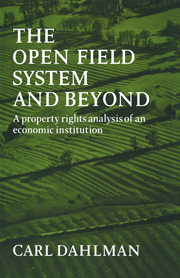Book contents
- Frontmatter
- Contents
- Preface
- 1 Introduction
- 2 Theories of the open field system
- 3 Property rights, transaction costs, and institutions
- 4 The economics of commons, open fields, and scattered strips
- 5 The economics of enclosure
- 6 Some extensions and generalizations
- Bibliography
- Index of names
- Index of subjects
2 - Theories of the open field system
Published online by Cambridge University Press: 07 October 2011
- Frontmatter
- Contents
- Preface
- 1 Introduction
- 2 Theories of the open field system
- 3 Property rights, transaction costs, and institutions
- 4 The economics of commons, open fields, and scattered strips
- 5 The economics of enclosure
- 6 Some extensions and generalizations
- Bibliography
- Index of names
- Index of subjects
Summary
Behind the innocuous phrase ‘the open field system’ two complex but related phenomena are hidden, and they are sometimes not easily distinguished. The first is that the system never was an unchanging and monolithic entity : there never was an open field system that had an identical shape all over England through the centuries from its appearance until its replacement with the modern system of farming. It is by now quite clear that the system was not ‘devised’ as a finished product of human ingenuity and implanted fully grown by rational, conscious decisionmakers. Rather, it grew over time in an unplanned manner: trial and error must have been the method by which the farmer chose to discard or preserve certain solutions to the problems of farming that he faced in dealing with soil, animals, climate, topography, crops, markets, transportation, and all the other conditions he must conform to in making his living. Thus, at any one moment there were open field villages in various stages of evolution : those that had already adopted what we have come to determine as the mainstays of open field farming, and those that were in the process of developing towards that final state. In addition to this problem of evolution, there is the added complication that whatever is understood by the term ‘open field system’, it never looked the same in all regions, even in a fully developed stage.
- Type
- Chapter
- Information
- The Open Field System and BeyondA property rights analysis of an economic institution, pp. 16 - 64Publisher: Cambridge University PressPrint publication year: 1980



